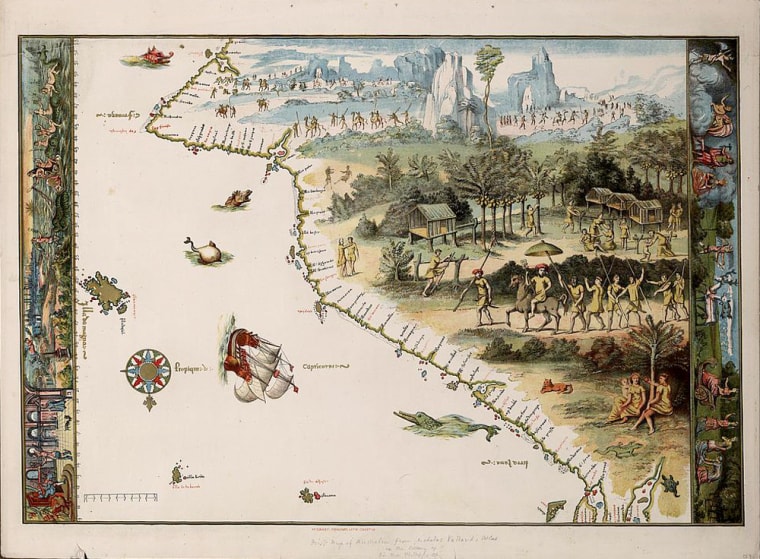A 16th-century maritime map shows that Portuguese adventurers, not the British or the Dutch, were the first Europeans to find Australia, according to a new book that details the story of the secret discovery.
The book “Beyond Capricorn” says the map, which accurately marks geographical sites along Australia’s east coast in Portuguese, proves that Portuguese seafarer Christopher de Mendonca led a fleet of four ships into Botany Bay in 1522 — almost 250 years before Britain’s Captain James Cook.
Australian author Peter Trickett said that when he enlarged the small map he could recognize all the headlands and bays in Botany Bay in Sydney — the site where Cook claimed Australia for Britain in 1770.
“It was even so accurate that I found I could draw in the modern airport runways, to scale in the right place, without any problem at all,” Trickett told Reuters on Wednesday.
Trickett said he stumbled across a copy of the map while browsing through a Canberra book shop eight years ago.
He said the shop had a reproduction of the Vallard Atlas, a collection of 15 hand-drawn maps completed no later than 1545 in France. The maps represented the known world at the time.
Why the maps were misaligned
Two of the maps called “Terra Java” had a striking similarity to Australia’s east coast, except at one point the coastline jutted out at right angles for 932 miles (1,500 kilometers).
“There was something familiar about them, but they were not quite right — that was the puzzle. How did they come to have all these Portuguese place names?” Trickett said.
Trickett believed the cartographers who drew the Vallard maps had wrongly aligned two Portuguese charts they were copying from.
It is commonly accepted that the French cartographers used maps and “portolan” charts acquired illegally from Portugal and Portuguese vessels that had been captured, Trickett said.
“The original portolan maps would have been drawn on animal hide parchments, usually sheep or goat skin, of limited size,” he explained. “For a coastline the length of eastern Australia, some 3,500 kilometers, they would have been three to four charts.
“The Vallard cartographer has put these individual charts together like a jigsaw puzzle. Without clear compass markings its possible to join the southern chart in two different ways. My theory is it had been wrongly joined.”
Using a computer Trickett rotated the southern part of the Vallard map 90 degrees to produce a map that accurately depicts Australia’s east coast.
“They provided stunning proof that Portuguese ships made these daring voyages of discovery in the early 1520s, just a few years after they had sailed north of Australia to reach the Spice Islands — the Moluccas. This was a century before the Dutch and 250 years before Captain Cook,” he said.
Secret mission?
Trickett believes the original charts were made by Mendonca, who set sail from the Portuguese base at Malacca with four ships on a secret mission to discover Marco Polo’s “Island of Gold” south of Java.
If Trickett is right, Mendonca’s map shows he sailed past Fraser Island off Australia’s northeast coast, into Botany Bay in Sydney, and south to Kangaroo Island off southern Australia, before returning to Malacca via New Zealand’s north island.
Mendonca’s discovery was kept secret to prevent other European powers reaching the new land, said Trickett, who believes his theory is supported by discoveries of 16th-century Portuguese artifacts on the Australian and New Zealand coasts.
